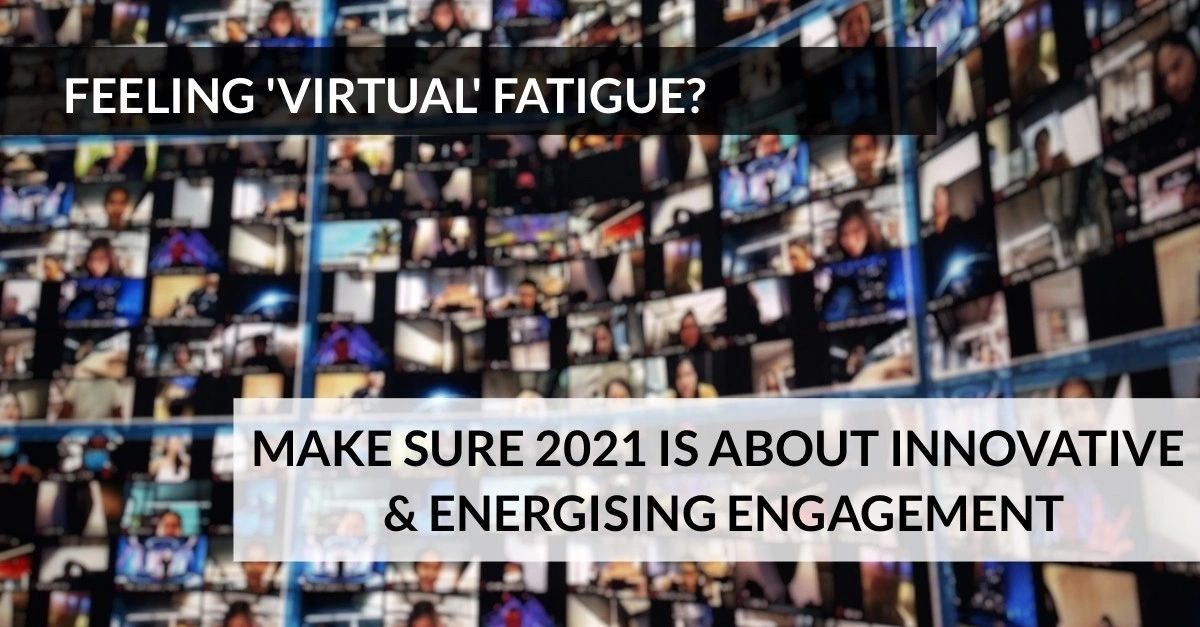
09 Dec Feeling Virtue fatigue yet?
I think it’s fair to say 2020 has been a mad year. The pandemic has wreaked havoc across the globe and the vast majority of offices are closed. This has forced many of us to work from home, unable to meet our colleagues face to face, or to visit our friends and family
The world of business has stepped up to the challenge of supporting a remote workforce surprisingly well. Relying on the likes of Zoom, WebEx and Microsoft Teams, businesses have adapted and innovated to keep their workforce connected virtually.
These virtual meetings have become part of our daily lives, and we all now have a funny moment or two to remember – from the cat blocking the camera, to the child demanding attention as someone desperately tries to deliver a presentation.
IS IT LOVE OR HATE?
Although we can affectionately look back on these moments and accept that virtual meetings are now a part of our lives, a bigger question is – do we love or hate this way of meeting, presenting and holding events? I believe the answer to that question carries some weight because I suspect that as the world has learnt how to work remotely, our ways of working will forever remain changed.
I am not suggesting that we won’t return to the office in some capacity but I think the workforce will now demand a more flexible working life balance. Now that we all know it’s possible to work just as effectively from our home study, the local coffee shop and the garden, we want to be able to put the washing on between calls or pick the kids up from school and keep working.
PREVENTING FATIGUE
As we prepare for this evolved approach to work life, we need to be careful that webinar and virtual event fatigue does not set in. Across all industries, people are expressing feelings of frustration and weariness when faced with endless presentations that don’t seem to take their needs or interests into account. Let’s be honest someone droning on at the other end of a screen from miles away is unlikely to capture anyone’s attention for long, if at all.
As we look forward, it is important that we don’t forget to keep innovating our communications, so that our colleagues, partners and customers remain engaged. Virtual really doesn’t have to mean boring, in fact quite the opposite.
KEEPING THEM TUNED IN
When I saw the impact of Covid, early in the crisis, I took a step back to think about how a business could engage an entire sector in an innovative way. That led to the birth of FlightPlan, a live broadcast event that ran in April. My goal for FlightPlan was to re-energise and reconnect an industry that was on its knees – aviation.
I knew this virtual event could not just be a ‘snorefest’ of expert presentations. So, I set about developing – with the help of some brilliant people – a seven-hour virtual event that attracted more than 3,000 participants, who stayed tuned in for more than two hours on average.
They stayed tuned in because the event combined interesting interviews with audience interaction and documentary style reviews. Yes, it also included a few presentations, but the quality was high, and we created a production. We treated our audience like you would a television audience.
The #FTEAPEXVirtualExpo happening this week is another example of how organisations are trying to innovate during the pandemic restrictions. The organisers have created a virtual auditorium, where attendees can visit virtual stands, chat with people on each stand in a group or individually, watch live demos and presentations, and even drop into a networking lounge.
HOW WOULD YOU DO IT?
Now, I am not suggesting that every business needs to create a seven hour broadcast event or virtual auditorium but I do think that applying some basic principles to how you engage your audience is vital, if you want to keep their attention.
Whether you’re planning a quick presentation, a one-hour meeting or a half-day event, for 5 people, 50 people or 5,000, you want to differentiate yourself from the endless stream of online content your audience is viewing. And PowerPoint isn’t going to cut it. To truly energise a workforce, we need to excite them. Have you thought about how you might do that? Not every idea will work, but if you do not trying to innovate then you will not know what works and what does not.
All I’m saying is that the phrase “death by PowerPoint” could quickly become “death by Zoom or WebEx or Teams”. Let’s not let that happen.
